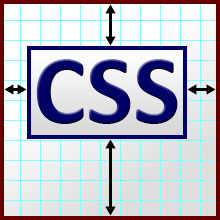The Two Ways of Sizing Absolute Elements in CSS
 Anyone who has used CSS for a while will know about the merits of absolute and relative positioning. To recap:
Anyone who has used CSS for a while will know about the merits of absolute and relative positioning. To recap:
position: relative allows an element to be shifted from its original position either horizontally (using left or right) or vertically (using top or bottom).
position: absolute allows an element to be positioned with respect to a containing block using left, right, top or bottom (the containing block is the nearest ancestor node with a position of relative, absolute or fixed).
Positioning nodes is therefore straightforward, e.g.
HTML:
<div id="outer">
<div id="inner"></div>
</div>
CSS:
#outer
{
position: relative;
width: 200px;
height: 200px;
margin: 20px auto;
border: 2px solid #c00;
}
#inner
{
position: absolute;
left: 50px;
top: 50px;
width: 96px;
height: 96px;
background-color: #ddc;
border: 2px solid #00c;
}
(The actual width and height of the inner block will be 100px owing to the addition of the border).
The following boxes are rendered in every modern browser (including IE6):
Less well known is that you can apply all the left, right, top and bottom properties at the same time. The following CSS will render the inner element identically:
#inner
{
position: absolute;
left: 50px;
right: 50px;
top: 50px;
bottom: 50px;
background-color: #ddc;
border: 2px solid #00c;
}
The width and height of the inner box will remain 100px, but we do not need to need to explicitly set the dimensions.
This could be useful when:
- the spacing around the element is more critical than the width or height. You can also use negative
left,right,topand/orbottomproperties to make the inner box larger than its outer parent. - you have multiple inner elements with differing borders and padding but need consistent outer spacing. This method allows you to create a single style for all those elements.
JavaScript animations can also benefit since it can be easier and quicker to resize an element if you do not need to calculate the resulting width and height, e.g.
// expands and contracts the inner box
window.onload = function() {
var inner = document.getElementById("inner");
var offset = 100, dir = -1;
setInterval(function() {
inner.style.left = inner.style.right = inner.style.top = inner.style.bottom = offset+"px";
offset += dir;
if (offset == 0 || offset == 100) dir = -dir;
}, 10);
}
A note about browser compatibility: this technique works in all the main browsers, except IE6 which only understands explicit widths and heights. There’s a surprise!
Frequently Asked Questions (FAQs) about CSS Sizing and Absolute Positioning
What is the difference between absolute and relative positioning in CSS?
In CSS, absolute and relative are two types of positioning methods. Absolute positioning allows an element to be positioned relative to the nearest positioned ancestor. This means that the element is taken out of the normal flow of the document and no space is created for the element in the page layout. On the other hand, relative positioning allows an element to be positioned relative to its normal position. This means that the positioning is relative to the element’s original position in the document flow, and space is still preserved for it in the page layout.
How does the ‘position: absolute’ property work in CSS?
The ‘position: absolute’ property in CSS removes an element from the normal document flow and positions it at a specified position relative to its closest positioned ancestor or to the initial containing block. The positioned element can be moved around using the ‘top’, ‘right’, ‘bottom’, and ‘left’ properties. However, if no ancestor elements have a position other than ‘static’, the initial containing block is used instead.
What is the use of ‘top’, ‘right’, ‘bottom’, and ‘left’ properties in CSS?
The ‘top’, ‘right’, ‘bottom’, and ‘left’ properties in CSS are used to position an element. These properties only have effects on positioned elements. They specify the distance between the element and one or more sides of its containing element. For example, ‘top: 20px’ means the top edge of the element will be 20px away from the top edge of its containing element.
How can I center an absolutely positioned element in CSS?
To center an absolutely positioned element, you can use the ‘left’ and ‘transform’ properties together. First, set ‘left: 50%’ to move the left edge of the element to the center of its parent. Then, use ‘transform: translateX(-50%)’ to pull the element back to the left by half of its own width, effectively centering it.
What is the difference between ‘absolute’ and ‘fixed’ positioning in CSS?
While both ‘absolute’ and ‘fixed’ positioning remove an element from the normal document flow, they differ in how they position the element. ‘Absolute’ positions the element relative to its nearest positioned ancestor or the initial containing block. ‘Fixed’, on the other hand, positions the element relative to the browser window. This means a fixed element will not move even if the page is scrolled.
How does CSS handle overlapping elements?
CSS handles overlapping elements using the ‘z-index’ property. This property specifies the stack order of an element, which is its position on the Z-axis. An element with a higher ‘z-index’ will be displayed in front of an element with a lower ‘z-index’.
What is the initial containing block in CSS?
The initial containing block in CSS is the containing block in which the root element (html) resides. It is typically the viewport of the browser window, but can also be the page box if the ‘overflow’ property of the root element is not ‘visible’.
How can I make an element fill the entire width and height of its parent element?
To make an element fill the entire width and height of its parent element, you can use the ‘width’ and ‘height’ properties and set them to ‘100%’. This will make the element as wide and as tall as its containing element.
What is the difference between ‘width’ and ‘max-width’ in CSS?
The ‘width’ property in CSS specifies the content width of an element, while the ‘max-width’ property sets the maximum width the element can stretch to when the content is larger than the specified width. If the content is smaller than the ‘max-width’, the content will remain at its natural size.
How can I make an element maintain its aspect ratio as it resizes?
To make an element maintain its aspect ratio as it resizes, you can use the ‘aspect-ratio’ property in CSS. This property defines the aspect ratio for the box, which is the ratio of the width to the height. For example, ‘aspect-ratio: 16 / 9’ will maintain a 16:9 aspect ratio.
Craig is a freelance UK web consultant who built his first page for IE2.0 in 1995. Since that time he's been advocating standards, accessibility, and best-practice HTML5 techniques. He's created enterprise specifications, websites and online applications for companies and organisations including the UK Parliament, the European Parliament, the Department of Energy & Climate Change, Microsoft, and more. He's written more than 1,000 articles for SitePoint and you can find him @craigbuckler.





